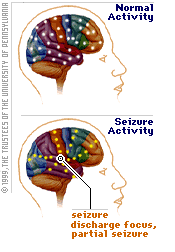

"What Is A Seizure?"
What is a seizure?
To understand what a seizure is, you must first understand how the brain works. Your brain is comprised of thousands of neurons – cells that process and transmit information by interacting with each other. These interactions can be observed and assessed through an electroencephalogram (EEG).
In most brains, neuron interactions occur in a chaotic but balanced, orderly fashion with few disruptions. Occasionally, small disruptions (neuron misfires) may occur with little consequence. When multiple cells misfire at the same time – depending on the severity and location in the brain – it may cause muscle twitches and spasms. This is a seizure. A seizure is defined as a sudden, electrical discharge in the brain causing alterations in behavior, sensation, or consciousness.
The difference between “epilepsy” and “seizures”
Many believe that having a seizure equates to having epilepsy. Although the two terms are often used simultaneously, a seizure (which is a single occurrence) is different than epilepsy (which is defined as two or more unprovoked seizures).
Seizures that appear to begin everywhere in the brain at once are classified as generalized seizures, while those beginning in one location of the brain are classified as partial seizures.
The three stages of a seizure
• Aura – The start of a partial seizure. If the aura is the only part an individual experiences, they’ve had a simple partial seizure. If the seizure spreads and affects consciousness, it is known as complex partial seizure. If the seizure spreads to the rest of the brain, it is classified as a generalized seizure.
• Ictus – Meaning stroke or attack, ictus is another word for the physical seizure.
• Postictal – Meaning after the attack, postictal refers to the aftereffects of the seizure, e.g., arm numbness, loss of consciousness, partial paralysis, etc.
here is some evidence that adults with epilepsy may benefit from the diet, and that a less strict regime, such as a modified Atkins diet, is similarly effective.[1] Clinical trials and studies in animal models suggest that ketogenic diets provide neuroprotective and disease-modifying benefits for a number of adult neurodegenerative disorders.[6][7] As of 2012, there is limited clinical trial data in these areas, and, outside of paediatric epilepsy, use of the ketogenic diet remains at the research stage.[4][8][9]
Types of Seizures
Seizures are divided into two major groups – depending on where they begin in the brain:
• Generalized seizures – Unlike partial seizures, generalized seizures seem to begin everywhere in the brain at once.
Types of generalized seizures include:
• Absence seizures (formerly known as petit mal seizures)
• Myoclonic seizures
• Clonic seizures• Tonic seizures• Tonic-clonic seizures (formerly known as grand mal seizures)
• Atonic seizures (drop attacks)
• Partial seizures – Also called “focal” or “local” seizures, partial seizures begin in one location of the brain

